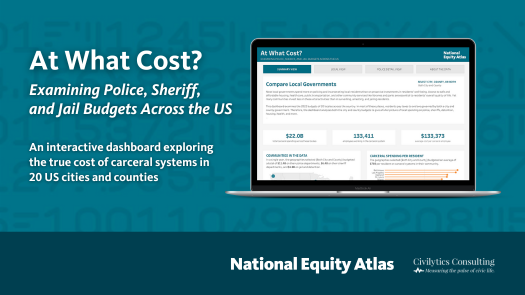Reflecting on 2024: Key Atlas Updates and Partnerships
Dear Atlas Users,
As 2024 draws to a close, we’re taking a moment to reflect on the year. It’s been filled with meaningful collaborations, data-driven insights, and impactful projects that continue to drive positive change in communities across the country. As we wrap up the year, we’re excited to share some of the highlights from 2024, and we’re also looking ahead to 2025 with some exciting projects in store that will continue to advance data equity nationwide.
Empowering Communities with Data to Strengthen Local Action
This year, we collaborated on key projects to support regional equity efforts across the US. In California, we developed seven regional equity profiles to support the California Jobs First initiative, a $600 million statewide effort to drive investments that strengthen communities. These profiles cover regions such as the Central Coast, Inland Empire, and Southern Border, providing valuable data and insights to address long-standing inequities, promote climate resilience, and ensure that new development benefits communities of color and historically disinvested areas. We also partnered with local organizations in Long Island to produce an updated equity profile for the region, providing an in-depth analysis of its economic challenges, environmental justice issues, and health disparities. Both projects underscore the importance of localized, data-driven approaches to advancing equity, with the power to inform community-led solutions and shape policy for a more equitable future.
Making Waves in the Media
Throughout 2024, the Atlas was featured in several media outlets, amplifying the reach and impact of our work. In August, The Seattle Times referenced our data in a report on the rise of unpaid rent in low-income housing, shedding further light on the financial struggles tenants face as rental arrears continue to mount. In April, Shelterforce cited our data in its analysis of deepening rental arrears and increasing operational costs faced by affordable housing providers. Our rent debt data also made its way into Capital & Main, where it was featured in a story about a Los Angeles renter preparing to fight for his home in court. And our collaborative study with Rideshare Drivers United was mentioned in a CalMatters article discussing the implications of Prop 22 and its impact on gig economy workers. To explore more media coverage, visit our news archive.
Addressing Economic Insecurity and Housing Pressures
This year, we released two critical pieces of research that highlighted the growing disparities in housing and community well-being. Our report on economic insecurity and green space equity in Los Angeles County uncovered significant racial and economic disparities in access to green spaces, revealing how these gaps affect the quality of life and exacerbate broader economic inequalities. Meanwhile, a data snapshot we released earlier in the year delved into the growing pressure US renters feel to leave their homes, particularly in regions like the South and Southwest, where financial strains were most acute. These insights, which were incorporated into our rent debt dashboard, underscored the urgent need for stronger protections for renters and equitable solutions to improve both housing stability and access to essential community resources like green spaces.
Celebrating the Conclusion of the National Equity Atlas Fellowship
In the first quarter of 2024, the second cohort of National Equity Atlas Fellows completed their equity data projects. The program concluded with a Fellowship Showcase, where each of them presented their projects—ranging from a transit equity dashboard in New Orleans to a toolkit on economic disparities caused by heir properties in Detroit. Post-fellowship interviews with both cohorts provided valuable reflections on their skill development and impact. As we look ahead, we’re retooling the Racial Equity Data Lab and refining our approach to continue promoting research justice and advancing data equity in the field.
Driving Conversations on Data and Equity at the PolicyLink Equity Summit 2024
We hosted three sessions at this year’s PolicyLink Equity Summit, each showcasing innovative approaches to advancing equity through data and community engagement. The first session examined transformative data systems, exploring the balance between data disaggregation and holistic analysis, while also addressing the ethical considerations surrounding the use of big data. In the second session, we shared strategies for creating accessible and impactful data visualizations that can drive meaningful change. The third session offered an immersive experience, inviting participants to think beyond traditional indicators and imagine new ways to measure and promote community well-being. To dive deeper into the sessions and access the resources we shared, visit nationalequityatlas.org/equity-summit-2024.
Looking Forward to the New Year
Thank you for using the National Equity Atlas and for your ongoing commitment to advancing equity through data, research, and collaboration. We wish you and yours a joyful holiday season and look forward to an even more impactful 2025!
— The National Equity Atlas Team at PolicyLink and the USC Equity Research Institute (ERI)





